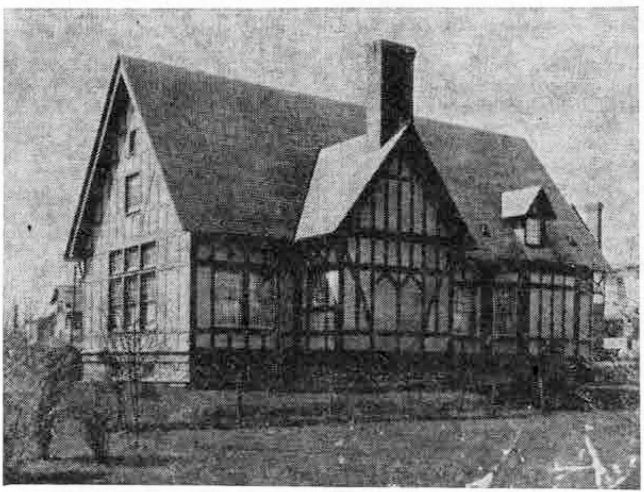The excerpts given in last week’s column from the old Bryn Mawr “Record” were found at the back of the Saturday Club pictured above, Since only parts of the newspaper remained, and these so brown with age as to be almost illegible, and so frail as to crumble at the touch, it was difficult for your columnist to read the date on which it was published. In last week’s column it was given as May 9, 1891. Your columnist has since decided that the year was 1901, not 1891 The news is therefore 53, not 63 years old.
An interesting note was added to last week’s column by A.M. Ehart, editor of “The Suburban,” giving the information that the old newspaper must have been a copy of the Bryn Mawr Record, a periodical which has long since been discontinued.
 This remarkably clear picture of the Saturday Club is especially interesting in that it shows the back of the building as it looked soon after it was finished in 1898. There are several old pictures of the front of the building, but this particular one seems to be the only one showing the rear view. It was taken from what now includes the rear yards of the Albrecht Flower Shop and the large building which houses the Wayne Beauty Salon on its first floor. The right rear side of the Club House now looks quite different from the picture, as it was enlarged some years ago to make the board room. Several windows were added, and a door replaced the window in the alcove.
This remarkably clear picture of the Saturday Club is especially interesting in that it shows the back of the building as it looked soon after it was finished in 1898. There are several old pictures of the front of the building, but this particular one seems to be the only one showing the rear view. It was taken from what now includes the rear yards of the Albrecht Flower Shop and the large building which houses the Wayne Beauty Salon on its first floor. The right rear side of the Club House now looks quite different from the picture, as it was enlarged some years ago to make the board room. Several windows were added, and a door replaced the window in the alcove.
The house just showing to the left of the picture is one across the street on West Wayne avenue, that was originally the property of Mr. and Mrs. A.M. Ware. It is older than the Saturday Club by several years. It was later occupied by Dr. and Mrs. H. Lee Scott, and quite recently, it has been remodelled into apartments. The home to the right of the club house, directly adjacent to it, has been for some years the headquarters of the Wayne Neighborhood League.
So much for the old picture. And now to continue with Radnor township news as given in the Bryn Mawr “Record” of May 9, 1901. Radnor High School had “just added lawn tennis to its list of out-of-door games,” the Board of Directors having granted permission to use that portion of the school grounds between the high school and the grammar school. The Athletic Association laid out four courts with others to be added as needed.
Just why tennis was considered particularly suitable for the girls it is now difficult to say. But “this form of exercise” was “introduced primarily for the purpose of giving the girls some kind of out-of-door exercise.” The regular indoor gymnastic work of the school was suspended for the balance of the school year in order to allow time for instruction in tennis.
Radnor’s relay team had just journeyed to Swarthmore on the previous Saturday “to take part in the races given in connection with the annual college games. Radnor easily won first place with Lower Merion in second place, and Norristown High School’s baseball team had just scored a victory over the Radnor team by a 38-13 score. The latter was soon to play Lansdowne High.
Mrs. Ralston C. Ware was president of the Saturday Club at this time. A musical program had featured the last meeting of the club, the program opening with a piano duet by Dr. George Miles Wells and Mrs. C.M. Custer. Other local musicians to appear on the program were Miss Jessie L. Fulweiler, Master Lucien Phillips, Reginald Makin, Mrs. David J. Hoopes and George B. Wilson. “The Fishermaiden,” a cantata, was sung by the “ladies of the Club Chorus.”
One of Radnor township’s leading citizens, John H. Converse, of Rosemont, had been given a reception at the Academy of Fine Arts in Philadelphia in recognition of his services to the Presbyterian Church. An audience, numbering about 2500, was present, including Justices of the Supreme Court, many public officials, officers of financial institutions and numerous clergymen of several denominations. In presenting a silver loving cup to Mr. Converse, Dr. William Henry Roberts, of Wayne, spoke for the assembled clergymen.
Last, but not least among the articles in the Bryn Mawr “Record” of 53 years ago which attracted your columnist’s attention was “Local Historical Sketch,” apparently part VII of a series written by an unnamed writer about the “Original German Settlement Around Strafford.” The Old Eagle School, of which the writer of “Your Town and My Town” has told so much in these columns from time to time, is described more than 50 years ago as “one of the oldest school houses in the State, and so far as the writer has been able to ascertain, the only one distinctly preserved to the present generation.”
Then, as now, the historic aspect of the section of the country which we live interested the local columnist.
